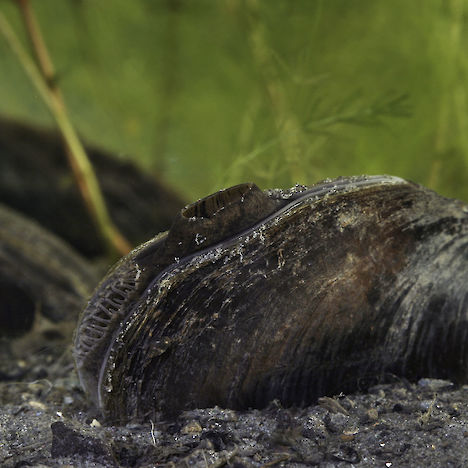Other names:
Kākahi, Hyridella spp.Threat category:
Threatened: Nationally Vulnerable, At Risk: Declining, At Risk: Naturally Uncommon?Regions:
Northland, Auckland, Waikato, Bay of Plenty, Gisborne, Hawkes Bay, Manawatu-Wanganui, Taranaki, Wellington, Nelson-Tasman, Marlborough, Westcoast, Canterbury, Otago, SouthlandDistribution:
Widespread.
Description
- Oval-shapped shell, hinged in centre.
- Shell is dark coloured with gold tinges.
- Occasionally an orange or other coloured encrustation on the shell may be present, as a result of a build up of minerals from surrounding waters.
Taxonomy
There are currently three freshwater mussels in the genus Echyridella which are listed as Threatened or At Risk:
- Echyridella aucklandica, found in the North Island and in the South Island from Lake Manapouri to Lake Hauroko, and classified as Threatened: Nationally Vulnerable;
- Echyridella menziesii, found throughout New Zealand, and classified as At Risk: Declining; and
- Echyridella onekaka, found in north west Nelson, and classified as At Risk: Naturally Uncommon.
Interesting Facts
- Kākahi are unique to New Zealand.
- Widespread throughout New Zealand, in habitats ranging from small, fast-flowing streams to rivers and lakes.
- Are a valuable mahinga kai species.
- Have a complex lifecyle - their parasitic larvae attach to a host fish (most commonly koaro) and once carried upstream they drop off into soft, sandy sediments of rivers and lakes.
- Are long-lived, up to 50 years or more.
- Filter feed, in the same way that other shellfish do.
Association with Plantations
- Can occur in plantation forestry areas.
- Plantation streams and lakes often have relatively high populations of indigenous species.
Threats
- Destruction of riparian vegetation.
- Disturbance of banks and beds of waterways.
- Harvesting.
- Habitat destruction from:
- Modification of riparian margins.
- Introduction of aquatic weeds.
- Siltation.
- Eutrophication (high nutrients).
- Erosion of banks through grazing by livestock, goats and deer.
- Artificial barriers to upstream migration (e.g. culverts, fords with large lips creating a drop off).
- Depleted flows caused by water abstraction.
Management Options and Methods
- Maintain corridors of riparian vegetation along banks. Corridors should be as extensive as possible (refer to Buxton 1991).
- If possible, expand width of riparian zones during later rotation planting.
- Exclude livestock from riparian areas.
- Control deer and goats that could enter riparian areas.
- Comply with best forest operational management practices to avoid damage to riparian areas.
- Manage or prevent water abstraction from critical habitat areas.
- Regulate or prevent harvesting of threatened species.
- Prevent introductions of exotic fish.
- Prevent introductions of aquatic weeds. Educate local users of weed threats and how to prevent spread.
Monitoring Options
- Undertake surveys to identify presences of species and habitats.
- Consider repeating surveys every few years to ascertain whether key species are still present.
- Liaise with DOC about survey and monitoring methods.
- Report findings to DOC.
- Periodic checks of banks to ensure compliance with best forest operational management practices, pest and weed levels and siltation.
Further Information and Support
- DOC – advice for management, survey, and monitoring. Website http://www.doc.govt.nz/
- James, M. 1987. Ecology of the freshwater mussel, Hyridella menziesi (Gray) in a small oligotrophic lake. Arch. Hydrobiol. 108: 337-348.
- NIWA website. http://www.niwa.cri.nz


